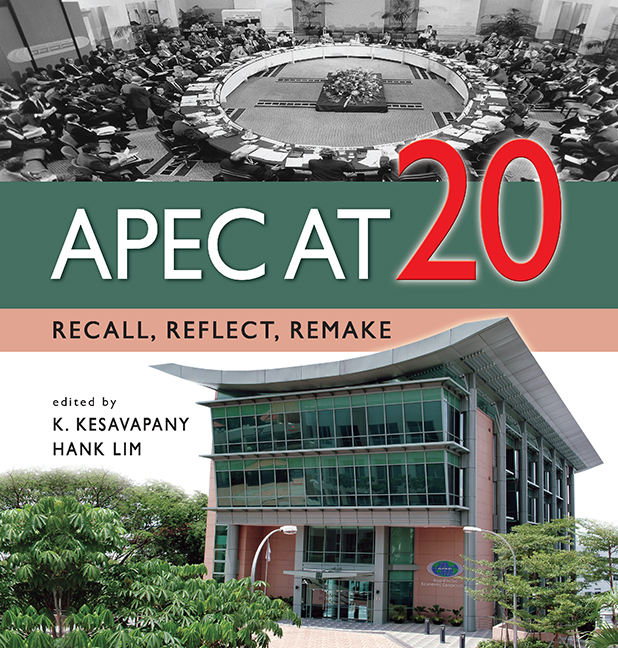Book contents
- Frontmatter
- Frontispiece
- contents
- Foreword by Ambassador Michael Tay
- Preface
- About the Authors
- Asia-Pacific Economic Cooperation (APEC)
- CHAPTER 1 APEC: Genesis and Challenges
- CHAPTER 2 APEC's Origins and its Future
- CHAPTER 3 Four Adjectives Become a Noun: APEC The Future of Asia-Pacific Cooperation
- CHAPTER 4 APEC's Eye on the Prize: Participants, Modality, and Confidence-Building
- CHAPTER 5 APEC: Taking Stock and Looking Ahead
- CHAPTER 6 Revamping APEC's Concerted Unilateral Liberalization
- CHAPTER 7 APEC at 20: Assessment of Trade/Investment Liberalization, Facilitation and Ecotech Activities
- CHAPTER 8 Integrating the Business Community in the APEC Process: Genesis of the Pacific Business Forum
- APPENDICES
- Index
CHAPTER 5 - APEC: Taking Stock and Looking Ahead
from Asia-Pacific Economic Cooperation (APEC)
Published online by Cambridge University Press: 21 October 2015
- Frontmatter
- Frontispiece
- contents
- Foreword by Ambassador Michael Tay
- Preface
- About the Authors
- Asia-Pacific Economic Cooperation (APEC)
- CHAPTER 1 APEC: Genesis and Challenges
- CHAPTER 2 APEC's Origins and its Future
- CHAPTER 3 Four Adjectives Become a Noun: APEC The Future of Asia-Pacific Cooperation
- CHAPTER 4 APEC's Eye on the Prize: Participants, Modality, and Confidence-Building
- CHAPTER 5 APEC: Taking Stock and Looking Ahead
- CHAPTER 6 Revamping APEC's Concerted Unilateral Liberalization
- CHAPTER 7 APEC at 20: Assessment of Trade/Investment Liberalization, Facilitation and Ecotech Activities
- CHAPTER 8 Integrating the Business Community in the APEC Process: Genesis of the Pacific Business Forum
- APPENDICES
- Index
Summary
Progress of APEC
The Asia-Pacific Economic Cooperation (APEC) forum was established in 1989 to capitalize on the growing interdependence of Asia-Pacific economies. By promoting market liberalization, facilitation and economic and technical cooperation, it intends to create a sound environment for long-term sustainable economic development and shared prosperity for all members. Its 21 member economies are home to more than 2.7 billion people and represent approximately 54 per cent of world GDP and 44 per cent of world trade. APEC has grown to become one of the world's most important regional groupings.
The APEC region has gained significant progress in facilitating the trade and investment liberalization process and intra-regional trade in general. When APEC was established in 1989, the average tariff rate in the region stood at 16.9 per cent. By 2004 barriers had been reduced by approximately 70 per cent to 5.5 per cent. Since APEC's inception, APEC's total trade has grown almost 4 times, GDP tripled, significantly outpacing the rest of the world. With the more liberalized market environment, the intra-APEC trade (exports and imports) has grown rapidly, from US$1.7 trillion in 1989 to US$8.44 trillion in 2007 — an average increase of 8.5 per cent per year, accounting for 67 per cent in 2007.
The composition of APEC's membership is a novel arrangement as it has brought together developing, newly industrializing and advanced industrial economies into a process of regional consultation and cooperation. To 21 APEC member economies, APEC is a unique forum, operating on the basis of open dialogue and respect for the views of all participants. It is a unique regional institution committed to reducing barriers to trade and investment following the approach of voluntary actions and enhancing the economic and technical cooperation aiming at capacity building and reducing the economic development gaps, i.e. by individual action plans (IAPs) without requiring its members to enter into legally binding obligations and collective action plans (CAPs) based on the members’ commitments.
- Type
- Chapter
- Information
- APEC at 20Recall, Reflect, Remake, pp. 57 - 66Publisher: ISEAS–Yusof Ishak InstitutePrint publication year: 2009

